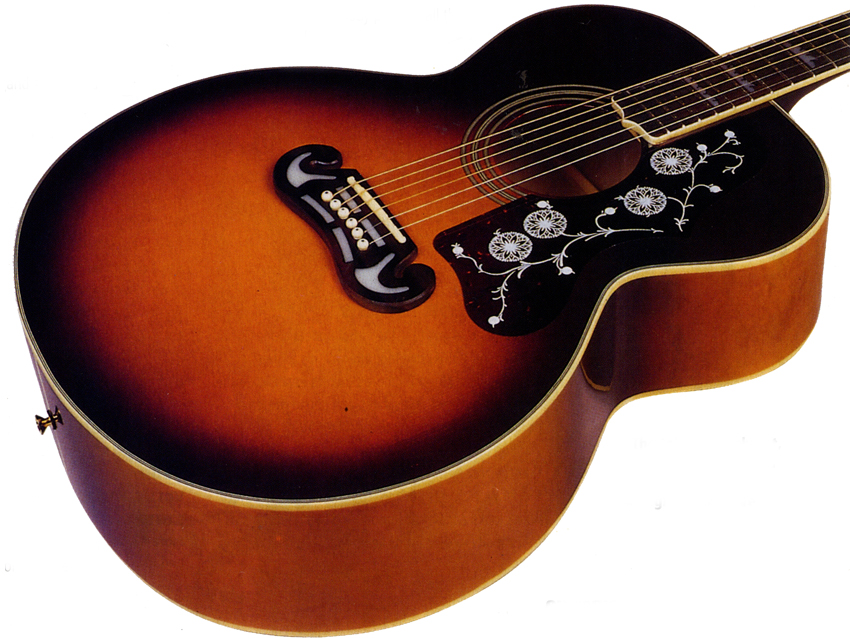MusicRadar Verdict
You'd be hard pushed to get more guitar for the money; it plays well, sounds good and looks killer.
Pros
- +
Punches above its weight.
Cons
- -
Bridge could have done with more work.
MusicRadar's got your back
Sitting side by side in our studio is this Epiphone EJ200 and a rare, birds eye maple-topped PRS. You'd assume that anyone with any idea about guitars would head straight for the PRS. Oh no.
While we love this PRS, we've spent more time eyeing the £359 Epiphone than any guitar for ages. The EJ200, like its more famous Gibson cousin, has a presence all its own, and that makes it special.
Build
The tobacco sunburst maple body, with front and rear edge binding and spruce top, is as good as any other guitar in this price-range. There are no tell-tale blemishes or overspray to hint at the EJ200's humble origins, and the lacquer is just the right shade to add a convincing hint of age.
A rosewood fingerboard is edgebound to the maple neck and quality is maintained right up to the headstock, which carries six adjustable, gold-plated Gotoh tuners. The revered Gibson name sits on the truss rod cover, the Epiphone name on the headstock, and the whole assembly stands up well to close scrutiny.
The weakest points are the crown inlays set into the fingerboard, which have a bit too much filler around them. But the internal bracing is cleanly finished with no excess glue, and the finish around the soundhole is done well.
The nut has been superbly cut and fitted and the 20 thin frets are finished better than you might expect on a guitar in this price bracket. The bridge, on the other hand, could have done with a bit more work; it's scrappy in places.
Playability
If this were a four figure Gibson J200, we'd be looking for a guitar with a fat, rich bass end; one for strumming, not picking. The Epiphone EJ is tonally better balanced for general playing, with a more even spread of tone across the strings.
The action is lighter and lower than you'd expect from an acoustic, so while this is still a guitar that likes to be strummed, the more even balance means that the Epiphone is good for pickers as well. In fact, this would make a great guitar for country picking, because the low action and even response make it quite fast. And it's got the look that just makes you want to pick it up and play.
We were impressed at how quickly the EJ200 settled down from when it was first unpacked. Initially the tone was a little hard and edgy, but over a few days, as it was played in, it developed a warmer, smoother sound, with stable tuning and great recorded tone.
The jumbo-sized body projects well and the guitar is always comfortable to play, either standing or sitting. An endpin strap button sits in the usual place, but there's no second one at the heel. One solution is to attach a strap around the neck at the headstock, as Elvis Presley used to do with his Gibson.
Sound
If you're under the impression that cheap acoustics sound that way and that's the end of it, then the EJ200 might well force you to think again. Everybody accepts that guitars in this price bracket aren't made from the best solid tonewoods available, and so it might seem a bit daft to talk about sound quality; don't they all sound much the same?
Well, not really. A Korean guitar like this would be good enough to use live, whereas some others we've seen simply wouldn't. We've already mentioned the evenness of the sound projection, but this is wood we're talking about here, and even laminated guitars will improve with age.
This one has already started, and while it couldn't be expected to go head to with a Gibson J200 - or any other acoustic with the kind of price tag a J200 can command - it stands out well from the crowd. There's a slight hint of boxiness to the tone, but I reckon this big Epi should mellow down to become a very usable guitar.
We're tempted to say that the visual appeal alone justifies the price tag; after all, it's a great looking guitar. But on a more down to earth level, the construction, finish, playability and sound are on a par with a guitar costing significantly more.
The problem with cheaper acoustic instruments is that their looks and finish can be uninspiring, and their tone plain off-putting. The EJ200, on the other hand, looks and sounds good, and we've no doubts as to its ability in earning its keep.
It doesn't matter what a guitar costs; if it doesn't do what's expected of it, then it's not really money well spent. The Epiphone EJ200 performed well and sounded good and we think you'd be hard pushed to get more guitar for the money. It's certainly won new friends around here.
Originally reviewed in Guitarist magazine, August 1997.
Guitarist is the longest established UK guitar magazine, offering gear reviews, artist interviews, techniques lessons and loads more, in print, on tablet and on smartphones Digital: http://bit.ly/GuitaristiOS If you love guitars, you'll love Guitarist. Find us in print, on Newsstand for iPad, iPhone and other digital readers
“If they were ever going to do the story of Nero, probably the most decadent of all the emperors, they would have to use Roy Thomas Baker”: A tribute to the legendary producer of Queen, Alice Cooper, Journey and more
“Built from the same sacred stash of NOS silicon transistors and germanium diodes, giving it the soul – and snarl – of the original”: An octave-fuzz cult classic returns as Jam Pedals resurrects the Octaurus
What’s the buzz? Meet Yellowjacket, Cherry Audio's recreation of EDP’s trend-setting Wasp from 1978











